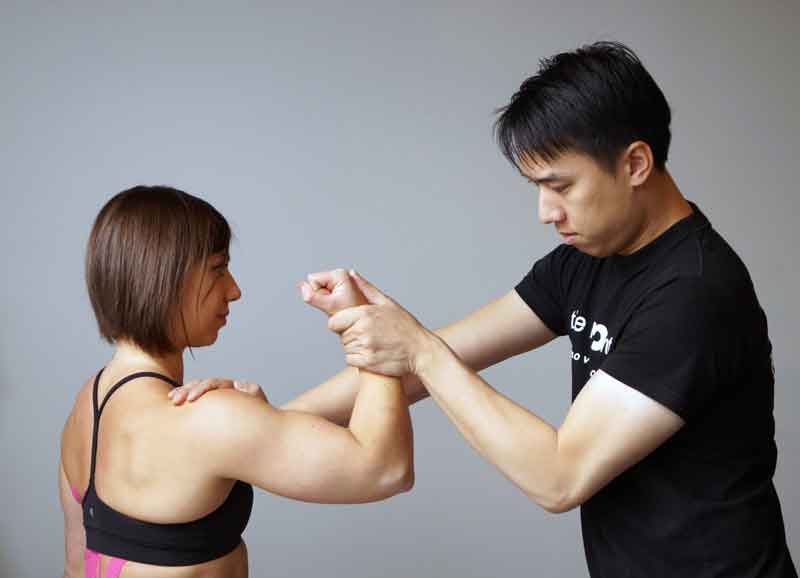Aerial silk, tumbling mats… Dr. Martin Lai has a few more tools of the trade beyond the table!


Chiropractors are well-known for their training in a variety of techniques and tools like adjustments and joint manipulations, soft-tissue therapy and Graston instruments and kinesiology tape. But these aren’t the only tools that chiropractors might use.
As you step into Dr. Martin Lai’s clinic, The Hip Joint, tucked away in the east end of Toronto and just minutes from major media production studios, you’ll notice even more equipment like aerial silks and poles, tumbling mats, and gymnastic blocks. With most of his patients coming from the performing arts, having this equipment available gives room for his patients to be seen and heard in their own language.
“My job is to figure out what tools can I use to help my patients. Adjustments are just one tool of the trade. They work for a lot of people, but they aren’t for everybody!”
Dr. Lai
“My job is to figure out what tools can I use to help my patients,” said Dr. Lai. “Adjustments are just one tool of the trade. They work for a lot of people, but they aren’t for everybody!”
A good friend of Dr. Lai’s was a ballet dancer who eventually became a competitive aerial dancer. Because she wanted to keep pushing her abilities, Dr. Lai visited her studio and attended competitions to provide on-the-spot chiropractic care. By supporting his friend and her dance community, he grew a network of patients that include competitive and professional dancers, acrobats and aerialists, and contortionists. He uses the same approach as when someone expresses that they can’t do their job waiting tables or sit at their desk without aches and pains.
“When a patient comes to me asking, ‘Why can’t I stick this landing?’ or ‘Why can’t I do this move?’ it’s not my job to say, ‘You’re not supposed to be able to do that.’ It’s my job to have an open eye to see what people want to do and how to support that.”
Dr. Lai explains that most research and education focuses on the average person’s ability. He took that knowledge and used it to support his patients’ “outlier” needs. For example, the average person should be able to turn their head 90 degrees to the left or right. But when he has acrobats that need to turn their head beyond 90 degrees for their jobs, he is tasked with figuring out how to fix what’s blocking them.


“Sure, the average person shouldn’t be able to put the feet behind their back and touch their head but for some of my patients this is normal and it’s their livelihood,” explained Dr. Lai. “It doesn’t matter if you’re a contortionist or someone who sits at a desk all day, I need to be able to see what you’re doing when you start to hurt. Then I can figure out how to help alleviate that. That’s why we have all this equipment!”
Dr. Lai wasn’t always a chiropractor, but he has been involved in the rehabilitation world for most of his professional life. It started with folding towels at a physiotherapy clinic as a part time job, to supporting a chiropractor as a kinesiologist. He also found himself working in disability case management and workplace arbitration.
Being a case manager left Dr. Lai feeling unfulfilled because he couldn’t help people get back to doing what they loved: back to the field, back to the office, back to their livelihood. That’s when he decided to advance his skills and attend chiropractic school. Now, his job was more than “pointing out problems.” He devotes his time and skills to help people solve their problems.
Visiting a chiropractor for the first time can be overwhelming, especially if you are already experiencing stress and pain. A caring chiropractor will take the time to help you feel comfortable, listen to your situation, and work with you to create a sustainable treatment plan. Some other chiropractic “tools” and techniques that Dr. Lai and many other others offer include:
Designed comfort: As soon as you step into The Hip Joint, patients feel an immediate calming effect due to the space being filled with natural daylight and soft lamps that shine upward. Dr. Lai explains the upward lighting aligns with the direction of a patient’s gaze when they are lying down on a bed. Taking away the bright fluorescent lights beaming down, patients can take a moment to calm down before expressing their pain or issues.
Educational patient communication: Before assigning “homework” exercises or movements to do at home, Dr. Lai takes additional time to see his patients do the movements properly before he ends an appointment. While some appointments might run long because of this, he knows he’s doing everything in his power to prepare patients to succeed on their own time.
Thoughtful accessibility: Dr. Lai selected a location that would be close to his patients’ workplaces making it easier to drop in for their appointments. He found a building that has elevators and designed the pathways within the clinic to be wide enough to fit wheelchairs and mobility devices.
Every patient will have unique set of needs whether it’s chronic pain, rehabilitation from an injury, or improving your ability to perform an aerial back flip. Patients are encouraged to find a chiropractor that they feel is right for their needs.
Check out our Find A Chiro tool to find a chiropractor near you.